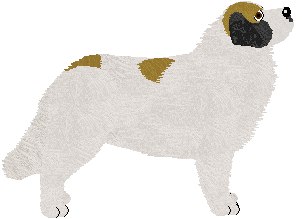Like many breeds, the pyrenean mastiff's history consists of many guesses and few facts. Great mastiff-like dogs have been known for thousands of years. It has been speculated that the dogs arriving with the molossoids, who wandered to Greece from the East about 500 B.C, may have come from Tibet. The pyrenenan mastiff does resemble the tibetan mastiff, but another guess is the fact that the fenicians traded with the Pyrenean peninsula, and the great dogs are considered to have come from Syria or India, gradually spreading over the peninsula and developing into breeds like the spanish mastiff, rafeiro do alentejo, pyrenean mountain dog and pyrenean mastiff. The mastiff was developed in the mountain areas between the western and eastern parts of the Pyreneans. It has also been called 'Navarro mastiff' and in the early 1900s was regarded as the largest spanish mastiff. Technically, it is however not a mastiff but a molossoid mountain dog. It was entered in a dog show for the first time in 1890, but has traditionally been kept as a flock guardian, with many legends describing its courage, aggression and strength.
As the wolves became extinct in the area, the dogs lost in popularity, which was noted even when the breed standard was written in 1946. In the 1970s, the interest was back, and the few remaining pyrenean mastiffs formed the basis of the breed as we know it today.
The pyrenean mastiff should be very large, very powerful and muscular, with heavy boning. Despite this, it must not appear clumsy. The body is rectangular, the tail powerful and hanging with a hook at the end. The head is large and broad, with a deep muzzle that thins slightly towards the tip of the nose. It is a calm and noble breed, an excellent guard dog that takes its job very seriously.





 or
or  (not preferred)
(not preferred) overlay.
overlay.



 with
with  striping.
striping. (standard mask)
(standard mask) in the piebald or extreme spotting pattern. Head must always be coloured, with or without white muzzle and/or blaze. May have ticking.
in the piebald or extreme spotting pattern. Head must always be coloured, with or without white muzzle and/or blaze. May have ticking.


